- About This Guide
- Index
- Glossary
-
- Configuring IPSec and ISAKMP
- Configuring L2TP over IPSec
- Setting General VPN Parameters
- Configuring Tunnel Groups, Group Policies, and Users
- Configuring IP Addresses for VPN
- Configuring Remote Access VPNs
- Configuring Network Admission Control
- Configuring Easy VPN on the ASA 5505
- Configuring the PPPoE Client
- Configuring LAN-to-LAN VPNs
- Configuring Clientless SSL VPN
- Configuring AnyConnect VPN Client Connections
- Configuring AnyConnect Host Scan
- Information About Service Policies
- Licensing Requirements for Service Policies
- Guidelines and Limitations
- Default Settings
- Task Flows for Configuring Service Policies
- Identifying Traffic (Layer 3/4 Class Maps)
- Defining Actions (Layer 3/4 Policy Map)
- Applying Actions to an Interface (Service Policy)
- Monitoring Modular Policy Framework
- Configuration Examples for Modular Policy Framework
- Feature History for Service Policies
Configuring a Service Policy Using the Modular Policy Framework
Service policies using Modular Policy Framework provide a consistent and flexible way to configure ASA features. For example, you can use a service policy to create a timeout configuration that is specific to a particular TCP application, as opposed to one that applies to all TCP applications. A service policy consists of multiple actionsapplied to an interface or applied globally.
This chapter includes the following sections:
- Information About Service Policies
- Licensing Requirements for Service Policies
- Guidelines and Limitations
- Default Settings
- Task Flows for Configuring Service Policies
- Identifying Traffic (Layer 3/4 Class Maps)
- Defining Actions (Layer 3/4 Policy Map)
- Applying Actions to an Interface (Service Policy)
- Monitoring Modular Policy Framework
- Configuration Examples for Modular Policy Framework
- Feature History for Service Policies
Information About Service Policies
This section describes how service policies work and includes the following topics:
- Supported Features
- Feature Directionality
- Feature Matching Within a Service Policy
- Order in Which Multiple Feature Actions are Applied
- Incompatibility of Certain Feature Actions
- Feature Matching for Multiple Service Policies
Supported Features
Table 30-1 lists the features supported by Modular Policy Framework.
|
|
|
|
|
|---|---|---|---|
|
|||
Chapter78, “Configuring NetFlow Secure Event Logging (NSEL)” |
|||
TCP and UDP connection limits and timeouts, and TCP sequence number randomization |
|||
Feature Directionality
Actions are applied to traffic bidirectionally or unidirectionally depending on the feature. For features that are applied bidirectionally, all traffic that enters or exits the interface to which you apply the policy map is affected if the traffic matches the class map for both directions.

Note![]() When you use a global policy, all features are unidirectional; features that are normally bidirectional when applied to a single interface only apply to the ingress of each interface when applied globally. Because the policy is applied to all interfaces, the policy will be applied in both directions so bidirectionality in this case is redundant.
When you use a global policy, all features are unidirectional; features that are normally bidirectional when applied to a single interface only apply to the ingress of each interface when applied globally. Because the policy is applied to all interfaces, the policy will be applied in both directions so bidirectionality in this case is redundant.
For features that are applied unidirectionally, for example QoS priority queue, only traffic that enters (or exits, depending on the feature) the interface to which you apply the policy map is affected. See Table 30-2 for the directionality of each feature.
|
|
|
|
|---|---|---|
TCP and UDP connection limits and timeouts, and TCP sequence number randomization |
||
Feature Matching Within a Service Policy
See the following information for how a packet matches class maps in a policy map for a given interface:
1.![]() A packet can match only one class map in the policy map for each feature type.
A packet can match only one class map in the policy map for each feature type.
2.![]() When the packet matches a class map for a feature type, the ASA does not attempt to match it to any subsequent class maps for that feature type.
When the packet matches a class map for a feature type, the ASA does not attempt to match it to any subsequent class maps for that feature type.
3.![]() If the packet matches a subsequent class map for a different feature type, however, then the ASA also applies the actions for the subsequent class map, if supported. See the “Incompatibility of Certain Feature Actions” section for more information about unsupported combinations.
If the packet matches a subsequent class map for a different feature type, however, then the ASA also applies the actions for the subsequent class map, if supported. See the “Incompatibility of Certain Feature Actions” section for more information about unsupported combinations.

Note![]() Application inspection includes multiple inspection types, and most are mutually exclusive. For inspections that can be combined, each inspection is considered to be a separate feature.
Application inspection includes multiple inspection types, and most are mutually exclusive. For inspections that can be combined, each inspection is considered to be a separate feature.
For example, if a packet matches a class map for connection limits, and also matches a class map for an application inspection, then both actions are applied.
If a packet matches a class map for HTTP inspection, but also matches another class map that includes HTTP inspection, then the second class map actions are not applied.
If a packet matches a class map for HTTP inspection, but also matches another class map that includes FTP inspection, then the second class map actions are not applied because HTTP and FTP inspections cannpt be combined.
If a packet matches a class map for HTTP inspection, but also matches another class map that includes IPv6 inspection, then both actions are applied because the IPv6 inspection can be combined with any other type of inspection.
Order in Which Multiple Feature Actions are Applied
The order in which different types of actions in a policy map are performed is independent of the order in which the actions appear in the policy map.

Note![]() NetFlow Secure Event Logging filtering and User statistics for Identity Firewall are order-independent.
NetFlow Secure Event Logging filtering and User statistics for Identity Firewall are order-independent.
Actions are performed in the following order:
2.![]() TCP normalization, TCP and UDP connection limits and timeouts, TCP sequence number randomization, and TCP state bypass.
TCP normalization, TCP and UDP connection limits and timeouts, TCP sequence number randomization, and TCP state bypass.

Note![]() When a the ASA performs a proxy service (such as AAA or CSC) or it modifies the TCP payload (such as FTP inspection), the TCP normalizer acts in dual mode, where it is applied before and after the proxy or payload modifying service.
When a the ASA performs a proxy service (such as AAA or CSC) or it modifies the TCP payload (such as FTP inspection), the TCP normalizer acts in dual mode, where it is applied before and after the proxy or payload modifying service.
4.![]() Application inspections that can be combined with other inspections:
Application inspections that can be combined with other inspections:
5.![]() Application inspections that cannot be combined with other inspections. The remaining application inspections cannot be combined with other inspections. See the “Incompatibility of Certain Feature Actions” section for more information.
Application inspections that cannot be combined with other inspections. The remaining application inspections cannot be combined with other inspections. See the “Incompatibility of Certain Feature Actions” section for more information.
Incompatibility of Certain Feature Actions
Some features are not compatible with each other for the same traffic. The following list may not include all incompatibilities; for information about compatibility of each feature, see the chapter or section for your feature:
- You cannot configure QoS priority queueing and QoS policing for the same set of traffic.
- Most inspections should not be combined with another inspection, so the ASA only applies one inspection if you configure multiple inspections for the same traffic. The only exceptions are listed in the “Order in Which Multiple Feature Actions are Applied” section.
- You cannot configure traffic to be sent to multiple modules, such as the ASA CX and ASA IPS.
- HTTP inspection is not compatible with the ASA CX.

Note![]() The match default-inspection-traffic command, which is used in the default global policy, is a special CLI shortcut to match the default ports for all inspections. When used in a policy map, this class map ensures that the correct inspection is applied to each packet, based on the destination port of the traffic. For example, when UDP traffic for port 69 reaches the ASA, then the ASA applies the TFTP inspection; when TCP traffic for port 21 arrives, then the ASA applies the FTP inspection. So in this case only, you can configure multiple inspections for the same class map. Normally, the ASA does not use the port number to determine which inspection to apply, thus giving you the flexibility to apply inspections to non-standard ports, for example.
The match default-inspection-traffic command, which is used in the default global policy, is a special CLI shortcut to match the default ports for all inspections. When used in a policy map, this class map ensures that the correct inspection is applied to each packet, based on the destination port of the traffic. For example, when UDP traffic for port 69 reaches the ASA, then the ASA applies the TFTP inspection; when TCP traffic for port 21 arrives, then the ASA applies the FTP inspection. So in this case only, you can configure multiple inspections for the same class map. Normally, the ASA does not use the port number to determine which inspection to apply, thus giving you the flexibility to apply inspections to non-standard ports, for example.
An example of a misconfiguration is if you configure multiple inspections in the same policy map and do not use the default-inspection-traffic shortcut. In Example 30-1, traffic destined to port 21 is mistakenly configured for both FTP and HTTP inspection. In Example 30-2, traffic destined to port 80 is mistakenly configured for both FTP and HTTP inspection. In both cases of misconfiguration examples, only the FTP inspection is applied, because FTP comes before HTTP in the order of inspections applied.
Example 30-1 Misconfiguration for FTP packets: HTTP Inspection Also Configured
Example 30-2 Misconfiguration for HTTP packets: FTP Inspection Also Configured
Feature Matching for Multiple Service Policies
For TCP and UDP traffic (and ICMP when you enable stateful ICMP inspection), service policies operate on traffic flows, and not just individual packets. If traffic is part of an existing connection that matches a feature in a policy on one interface, that traffic flow cannot also match the same feature in a policy on another interface; only the first policy is used.
For example, if HTTP traffic matches a policy on the inside interface to inspect HTTP traffic, and you have a separate policy on the outside interface for HTTP inspection, then that traffic is not also inspected on the egress of the outside interface. Similarly, the return traffic for that connection will not be inspected by the ingress policy of the outside interface, nor by the egress policy of the inside interface.
For traffic that is not treated as a flow, for example ICMP when you do not enable stateful ICMP inspection, returning traffic can match a different policy map on the returning interface. For example, if you configure IPS on the inside and outside interfaces, but the inside policy uses virtual sensor 1 while the outside policy uses virtual sensor 2, then a non-stateful Ping will match virtual sensor 1 outbound, but will match virtual sensor 2 inbound.
Licensing Requirements for Service Policies
|
|
|
|---|---|
Specific features may have separate license requirements. See the feature chapter for more information.
Guidelines and Limitations
This section includes the guidelines and limitations for this feature.
Supported in single and multiple context mode.
Supported in routed and transparent firewall mode.
Supports IPv6 for the following features:
- Application inspection for FTP, HTTP, ICMP, SIP, SMTP and IPsec-pass-thru, and IPv6.
- ASA IPS
- ASA CX
- NetFlow Secure Event Logging filtering
- TCP and UDP connection limits and timeouts, TCP sequence number randomization
- TCP normalization
- TCP state bypass
- User statistics for Identity Firewall
The maximum number of class mapsof all types is 255 in single mode or per context in multiple mode. Class maps include the following types:
- Layer 3/4 class maps (for through traffic and management traffic).
- Inspection class maps
- Regular expression class maps
- match commands used directly underneath an inspection policy map
This limit also includes default class maps of all types, limiting user-configured class mapsto approximately 235. See the “Default Class Maps” section.
See the following guidelines for using policy maps:
- You can only assign one policy map per interface. (However you can create up to 64 policy maps in the configuration.)
- You can apply the same policy map to multiple interfaces.
- You can identify up to 63 Layer 3/4 class maps in a Layer 3/4 policy map.
- For each class map, you can assign multiple actions from one or more feature types, if supported. See the “Incompatibility of Certain Feature Actions” section.
- Interface service policies take precedence over the global service policy for a given feature. For example, if you have a global policy with FTP inspection, and an interface policy with TCP normalization, then both FTP inspection and TCP normalization are applied to the interface. However, if you have a global policy with FTP inspection, and an interface policy with FTP inspection, then only the interface policy FTP inspection is applied to that interface.
- You can only apply one global policy. For example, you cannot create a global policy that includes feature set 1, and a separate global policy that includes feature set 2. All features must be included in a single policy.
- When you make service policy changes to the configuration, all new connections use the new service policy. Existing connections continue to use the policy that was configured at the time of the connection establishment. show command output will not include data about the old connections.
For example, if you remove a QoS service policy from an interface, then re-add a modified version, then the show service-policy command only displays QoS counters associated with new connections that match the new service policy; existing connections on the old policy no longer show in the command output.
To ensure that all connections use the new policy, you need to disconnect the current connections so they can reconnect using the new policy. See the clear conn or clear local-host commands.
Default Settings
The following topics describe the default settings for Modular Policy Framework:
Default Configuration
By default, the configuration includes a policy that matches all default application inspection traffic and applies certain inspections to the traffic on all interfaces (a global policy). Not all inspections are enabled by default. You can only apply one global policy, so if you want to alter the global policy, you need to either edit the default policy or disable it and apply a new one. (An interface policy overrides the global policy for a particular feature.)
The default policy includes the following application inspections:
- DNS inspection for the maximum message length of 512 bytes
- FTP
- H323 (H225)
- H323 (RAS)
- RSH
- RTSP
- ESMTP
- SQLnet
- Skinny (SCCP)
- SunRPC
- XDMCP
- SIP
- NetBios
- TFTP
- IP Options
The default policy configuration includes the following commands:

Note![]() See the “Incompatibility of Certain Feature Actions” section for more information about the special match default-inspection-traffic command used in the default class map.
See the “Incompatibility of Certain Feature Actions” section for more information about the special match default-inspection-traffic command used in the default class map.
Default Class Maps
The configuration includes a default Layer 3/4 class map that the ASA uses in the default global policy called default-inspection-traffic; it matches the default inspection traffic. This class, which is used in the default global policy, is a special shortcut to match the default ports for all inspections. When used in a policy, this class ensures that the correct inspection is applied to each packet, based on the destination port of the traffic. For example, when UDP traffic for port 69 reaches the ASA, then the ASA applies the TFTP inspection; when TCP traffic for port 21 arrives, then the ASA applies the FTP inspection. So in this case only, you can configure multiple inspections for the same class map. Normally, the ASA does not use the port number to determine which inspection to apply, thus giving you the flexibility to apply inspections to non-standard ports, for example.
Another class map that exists in the default configuration is called class-default, and it matches all traffic. This class map appears at the end of all Layer 3/4 policy maps and essentially tells the ASA to not perform any actions on all other traffic. You can use the class-default class if desired, rather than making your own match any class map. In fact, some features are only available for class-default, such as QoS traffic shaping.
Task Flows for Configuring Service Policies
This section includes the following topics:
- Task Flow for Using the Modular Policy Framework
- Task Flow for Configuring Hierarchical Policy Maps for QoS Traffic Shaping
Task Flow for Using the Modular Policy Framework
To configure Modular Policy Framework, perform the following steps:
Step 1![]() Identify the traffic—Identify the traffic on which you want to perform Modular Policy Framework actions by creating Layer 3/4 class maps.
Identify the traffic—Identify the traffic on which you want to perform Modular Policy Framework actions by creating Layer 3/4 class maps.
For example, you might want to perform actions on all traffic that passes through the ASA; or you might only want to perform certain actions on traffic from 10.1.1.0/24 to any destination address.
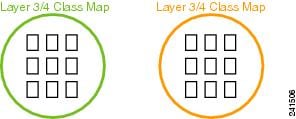
See the “Identifying Traffic (Layer 3/4 Class Maps)” section.
Step 2![]() Perform additional actions on some inspection traffic—If one of the actions you want to perform is application inspection, and you want to perform additional actions on some inspection traffic, then create an inspection policy map. The inspection policy map identifies the traffic and specifies what to do with it.
Perform additional actions on some inspection traffic—If one of the actions you want to perform is application inspection, and you want to perform additional actions on some inspection traffic, then create an inspection policy map. The inspection policy map identifies the traffic and specifies what to do with it.
For example, you might want to drop all HTTP requests with a body length greater than 1000 bytes.
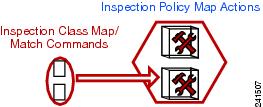
You can create a self-contained inspection policy map that identifies the traffic directly with match commands, or you can create an inspection class map for reuse or for more complicated matching. See the “Defining Actions in an Inspection Policy Map” section and the “Identifying Traffic in an Inspection Class Map” section.
Step 3![]() Create a regular expression—If you want to match text with a regular expression within inspected packets, you can create a regular expression or a group of regular expressions (a regular expression class map). Then, when you define the traffic to match for the inspection policy map, you can call on an existing regular expression.
Create a regular expression—If you want to match text with a regular expression within inspected packets, you can create a regular expression or a group of regular expressions (a regular expression class map). Then, when you define the traffic to match for the inspection policy map, you can call on an existing regular expression.
For example, you might want to drop all HTTP requests with a URL including the text “example.com.”
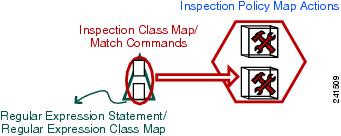
See the “Creating a Regular Expression” section and the “Creating a Regular Expression Class Map” section.
Step 4![]() Define the actions you want to perform and determine on which interfaces you want to apply the policy map—Define the actions you want to perform on each Layer 3/4 class map by creating a Layer 3/4 policy map. Then, determine on which interfaces you want to apply the policy map using a service policy.
Define the actions you want to perform and determine on which interfaces you want to apply the policy map—Define the actions you want to perform on each Layer 3/4 class map by creating a Layer 3/4 policy map. Then, determine on which interfaces you want to apply the policy map using a service policy.
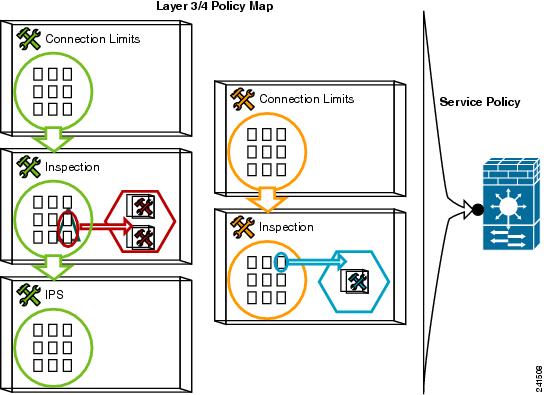
See the “Defining Actions (Layer 3/4 Policy Map)” section and the “Applying Actions to an Interface (Service Policy)” section.
Task Flow for Configuring Hierarchical Policy Maps for QoS Traffic Shaping
If you enable QoS traffic shaping for a class map, then you can optionally enable priority queueing for a subset of shaped traffic. To do so, you need to create a policy map for the priority queueing, and then within the traffic shaping policy map, you can call the priority class map. Only the traffic shaping class map is applied to an interface.
See “Information About QoS,” for more information about this feature.
Hierarchical policy maps are only supported for traffic shaping and priority queueing.
To implement a hierarchical policy map, perform the following steps:
Step 1![]() Identify the prioritized traffic according to the “Identifying Traffic (Layer 3/4 Class Maps)” section.
Identify the prioritized traffic according to the “Identifying Traffic (Layer 3/4 Class Maps)” section.
You can create multiple class maps to be used in the hierarchical policy map.
Step 2![]() Create a policy map according to the “Defining Actions (Layer 3/4 Policy Map)” section, and identify the sole action for each class map as priority.
Create a policy map according to the “Defining Actions (Layer 3/4 Policy Map)” section, and identify the sole action for each class map as priority.
Step 3![]() Create a separate policy map according to the “Defining Actions (Layer 3/4 Policy Map)” section, and identify the shape action for the class-default class map.
Create a separate policy map according to the “Defining Actions (Layer 3/4 Policy Map)” section, and identify the shape action for the class-default class map.
Traffic shaping can only be applied the to class-default class map.
Step 4![]() For the same class map, identify the priority policy map that you created in Step 2 using the service-policy priority_policy_map command.
For the same class map, identify the priority policy map that you created in Step 2 using the service-policy priority_policy_map command.
Step 5![]() Apply the shaping policy map to the interface accrding to “Applying Actions to an Interface (Service Policy)” section.
Apply the shaping policy map to the interface accrding to “Applying Actions to an Interface (Service Policy)” section.
Identifying Traffic (Layer 3/4 Class Maps)
A Layer 3/4 class map identifies Layer 3 and 4 traffic to which you want to apply actions. You can create multiple Layer 3/4 class maps for each Layer 3/4 policy map.
This section includes the following topics:
- Creating a Layer 3/4 Class Map for Through Traffic
- Creating a Layer 3/4 Class Map for Management Traffic
Creating a Layer 3/4 Class Map for Through Traffic
A Layer 3/4 class map matches traffic based on protocols, ports, IP addresses and other Layer 3 or 4 attributes.
Detailed Steps
|
|
|
|
|---|---|---|
|
|
Creates a Layer 3/4 class map, where class_map_name is a string up to 40 characters in length. The name “class-default” is reserved. All types of class maps use the same name space, so you cannot reuse a name already used by another type of class map. The CLI enters class-map configuration mode. |
|
|
|
||
Unless otherwise specified, you can include only one match command in the class map. |
||
|
|
||
match access-list access_list_name |
Matches traffic specified by an extended access list. If the ASA is operating in transparent firewall mode, you can use an EtherType access list. |
|
match port { tcp | udp } { eq port_num | range port_num port_num } |
Matches TCP or UDP destination ports, either a single port or a contiguous range of ports. |
|
match default-inspection-traffic |
Matches default traffic for inspection: the default TCP and UDP ports used by all applications that the ASA can inspect. This command, which is used in the default global policy, is a special CLI shortcut that when used in a policy map, ensures that the correct inspection is applied to each packet, based on the destination port of the traffic. For example, when UDP traffic for port 69 reaches the ASA, then the ASA applies the TFTP inspection; when TCP traffic for port 21 arrives, then the ASA applies the FTP inspection. So in this case only, you can configure multiple inspections for the same class map (with the exception of WAAS inspection, which can be configured with other inspections. See the “Incompatibility of Certain Feature Actions” section for more information about combining actions). Normally, the ASA does not use the port number to determine the inspection applied, thus giving you the flexibility to apply inspections to non-standard ports, for example. See the “Default Settings” section for a list of default ports. Not all applications whose ports are included in the match default-inspection-traffic command are enabled by default in the policy map. You can specify a match access-list command along with the match default-inspection-traffic command to narrow the matched traffic. Because the match default-inspection-traffic command specifies the ports and protocols to match, any ports and protocols in the access list are ignored. |
|
match dscp value1 [ value2 ] [...] [ value8 ] |
Matches DSCP value in an IP header, up to eight DSCP values. |
|
match precedence value1 [ value2 ] [ value3 ] [ value4 ] |
Matches up to four precedence values, represented by the TOS byte in the IP header, where value1 through value4 can be 0 to 7, corresponding to the possible precedences. |
|
|
|
Matches RTP traffic, where the starting_port specifies an even-numbered UDP destination port between 2000 and 65534. The range specifies the number of additional UDP ports to match above the starting_port, between 0 and 16383. |
|
| match flow ip destination-address |
Matches VPN tunnel group traffic to which you want to apply QoS. You can also specify one other match command to refine the traffic match. You can specify any of the preceding commands, except for the match any, match access-list, or match default-inspection-traffic commands. Or you can also enter the match flow ip destination-address command to match flows in the tunnel group going to each IP address. |
Examples
The following is an example for the class-map command:
Creating a Layer 3/4 Class Map for Management Traffic
For management traffic to the ASA, you might want to perform actions specific to this kind of traffic. You can specify a management class map that can match an access list or TCP or UDP ports. The types of actions available for a management class map in the policy map are specialized for management traffic. See the “Supported Features” section.
Detailed Steps
Defining Actions (Layer 3/4 Policy Map)
This section describes how to associate actions with Layer 3/4 class maps by creating a Layer 3/4 policy map.
Restrictions
The maximum number of policy maps is 64, but you can only apply one policy map per interface.
Detailed Steps
|
|
|
|
|---|---|---|
|
|
Adds the policy map. The policy_map_name argument is the name of the policy map up to 40 characters in length. All types of policy maps use the same name space, so you cannot reuse a name already used by another type of policy map. The CLI enters policy-map configuration mode. |
|
|
|
Specifies a previously configured Layer 3/4 class map, where the class_map_name is the name of the class map. See the “Identifying Traffic (Layer 3/4 Class Maps)” section to add a class map. Note If there is no match default-inspection-traffic command in a class map, then at most one inspect command is allowed to be configured under the class. |
|
See the “Supported Features” section. |
||
Repeat Step 2 and Step 3 for each class map you want to include in this policy map. |
Examples
The following is an example of a policy-map command for connection policy. It limits the number of connections allowed to the web server 10.1.1.1:
The following example shows how multi-match works in a policy map:
The following example shows how traffic matches the first available class map, and will not match any subsequent class maps that specify actions in the same feature domain:
When a Telnet connection is initiated, it matches class telnet_traffic. Similarly, if an FTP connection is initiated, it matches class ftp_traffic. For any TCP connection other than Telnet and FTP, it will match class tcp_traffic. Even though a Telnet or FTP connection can match class tcp_traffic, the ASA does not make this match because they previously matched other classes.
Applying Actions to an Interface (Service Policy)
To activate the Layer 3/4 policy map, create a service policy that applies it to one or more interfaces or that applies it globally to all interfaces.
Restrictions
You can only apply one global policy, so if you want to alter the global policy, you need to either edit the default policy or disable it and apply a new one. By default, the configuration includes a global policy that matches all default application inspection traffic and applies inspection to the traffic globally. The default service policy includes the following command:
Detailed Steps
Examples
For example, the following command enables the inbound_policy policy map on the outside interface:
The following commands disable the default global policy, and enables a new one called new_global_policy on all other ASA interfaces:
Monitoring Modular Policy Framework
To monitor Modular Policy Framework, enter the following command:
|
|
|
|---|---|
|
|
Configuration Examples for Modular Policy Framework
This section includes several Modular Policy Framework examples and includes the following topics:
- Applying Inspection and QoS Policing to HTTP Traffic
- Applying Inspection to HTTP Traffic Globally
- Applying Inspection and Connection Limits to HTTP Traffic to Specific Servers
- Applying Inspection to HTTP Traffic with NAT
Applying Inspection and QoS Policing to HTTP Traffic
In this example (see Figure 30-1), any HTTP connection (TCP traffic on port 80) that enters or exits the ASA through the outside interface is classified for HTTP inspection. Any HTTP traffic that exits the outside interface is classified for policing.
Figure 30-1 HTTP Inspection and QoS Policing
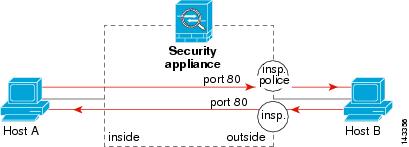
See the following commands for this example:
Applying Inspection to HTTP Traffic Globally
In this example (see Figure 30-2), any HTTP connection (TCP traffic on port 80) that enters the ASA through any interface is classified for HTTP inspection. Because the policy is a global policy, inspection occurs only as the traffic enters each interface.
Figure 30-2 Global HTTP Inspection
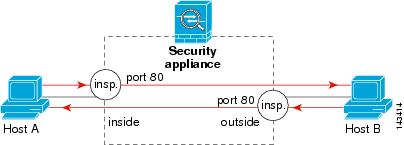
See the following commands for this example:
Applying Inspection and Connection Limits to HTTP Traffic to Specific Servers
In this example (see Figure 30-3), any HTTP connection destined for Server A (TCP traffic on port 80) that enters the ASA through the outside interface is classified for HTTP inspection and maximum connection limits. Connections initiated from Server A to Host A does not match the access list in the class map, so it is not affected.
Any HTTP connection destined for Server B that enters the ASA through the inside interface is classified for HTTP inspection. Connections initiated from Server B to Host B does not match the access list in the class map, so it is not affected.
Figure 30-3 HTTP Inspection and Connection Limits to Specific Servers
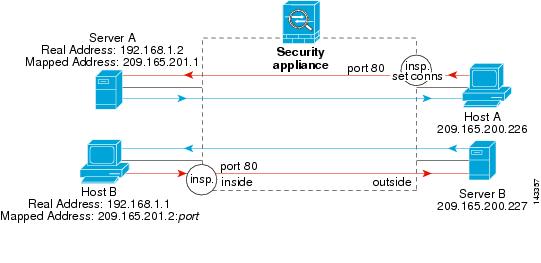
See the following commands for this example:
Applying Inspection to HTTP Traffic with NAT
In this example, the Host on the inside network has two addresses: one is the real IP address 192.168.1.1, and the other is a mapped IP address used on the outside network, 209.165.200.225. Because the policy is applied to the inside interface, where the real address is used, then you must use the real IP address in the access list in the class map. If you applied it to the outside interface, you would use the mapped address.
Figure 30-4 HTTP Inspection with NAT

See the following commands for this example:
Feature History for Service Policies
Table 30-3 lists the release history for this feature.
 Feedback
Feedback